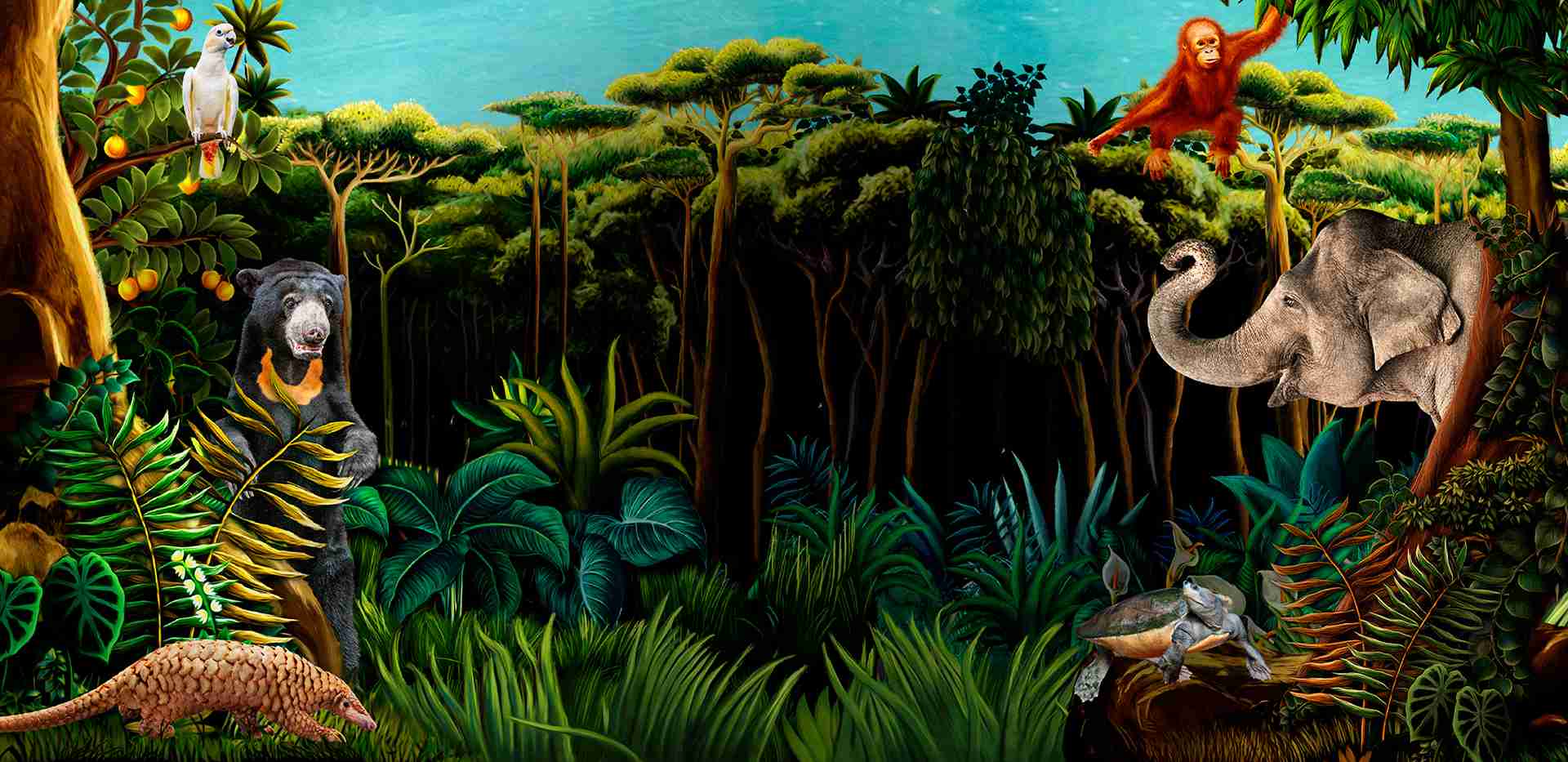Launch of National Conservation Strategy and Action Plan gives boost to Sunda Pangolin conservation in Singapore
18 SEP 2018
Sandshrew the Sunda Pangolin curled up in his den in Night Safari.
Rescued in 2017, Sandshrew is the first Sunda Pangolin hand-raised for the
purpose of release. His release process is a prime example of the Sunda
Pangolin National Conservation Strategy and Action Plan in action and will help
to develop future Sunda Pangolin rehabilitation and release protocols.
PHOTO CREDITS: WILDLIFE RESERVES SINGAPORE
Mr Desmond Lee, Minister for Social and Family Development and Second
Minister for National Development and Ade Kurniawan, Life Sciences Associate, Wildlife Reserves Singapore, checking on Sandshrew in his nest box after his journey to his soft release site. The release process for Sandshrew began today with Minister Lee assisting with his transfer to his soft release enclosure.
PHOTO CREDITS: WILDLIFE RESERVES SINGAPORE
For years, wildlife stakeholders and government agencies worldwide have sought to protect the species—an unassuming yet charismatic mammal that sports scales, has no teeth, and curls into a tight ball when it feels threatened. In 2017, 50 conservationists, including some international experts, convened at Singapore Zoo for a workshop to consider the status of the pangolin in Singapore and discuss the way forward for its conservation in the long-term.
Looking ahead towards the next 50 years, the gathering led to a vision and aspirational document—the National Conservation Strategy and Action Plan for Sunda Pangolins in Singapore—to be implemented by the Singapore Pangolin Working Group, which consists of government agencies, non-governmental organisations, tertiary institutions and other individuals. This effort was led by Wildlife Reserves Singapore (WRS) and the National Parks Board (NParks), with support from the IUCN SSC Pangolin Specialist Group, IUCN SSC Asian Species Action Partnership, and IUCN SSC Conservation Planning Specialist Group.
NParks’ Group Director of Conservation, Dr Adrian Loo, said, “In-situ conservation efforts over the years have helped to enhance the ecosystem needed for various native species, including the Sunda Pangolin, to thrive. These efforts include setting aside buffer parks and restoring the habitats in these nature parks, and incorporating culverts to facilitate movement across habitats. In addition, projects like the Eco-Link@BKE have helped to increase the foraging area and connectivity for the species. It is an immediate priority to coordinate and intensify conservation efforts in order to continue to support the conservation of our Sunda Pangolin population. With the launch of the National Conservation Strategy and Action Plan, NParks looks forward to greater collaboration with the various stakeholders to guide the development of long-term conservation and management strategies for this species.”
The vision of the group is: The iconic Sunda Pangolin is a widely-cherished part of Singapore’s natural heritage. Thriving populations live across well-connected natural habitats and urban landscapes, where their needs are sensitively incorporated into Singapore’s development. Coordinated conservation efforts by all stakeholders are successful in eliminating threats, including roadkill, poaching, and trafficking.
To secure a thriving future for the Sunda Pangolin, five goals have been established to pave the way for conservation action:
1. To gather and share information on the Sunda Pangolin’s status, ecology, biology and behaviour through ongoing studies and new initiatives.
2. To ensure viable populations through habitat protection, restoration, and connectivity.
3. To establish wildlife-conscious urban planning policies and measures that protect Sunda Pangolins.
4. To develop successful rescue, rehabilitation and release strategies for the Sunda Pangolin and secure the resources to implement them.
5. To generate collaborations, clear communication, and awareness across all relevant agencies and solidify a commitment to the conservation of Sunda Pangolins.
Mr Mike Barclay, Group Chief Executive Officer, Mandai Park Holdings said, “In 2009, Night Safari Singapore became the first zoological institution to display the Sunda Pangolin and later to breed the species under human care. But this alone is not enough. To save this iconic animal in Singapore, we need to work together on a comprehensive and coordinated plan. We are thus optimistic that the National Conservation Strategy and Action Plan will allow pangolins to co-exist with us in our densely populated city.”
Rescue, rehabilitation and release of Sandshrew
A key example of the Sunda Pangolin National Conservation Strategy and Action Plan in action is the rescue and rehabilitation of a baby pangolin for release by the working group. In January 2017, a stranded baby pangolin was rescued and sent to the Wildlife Health and Research Centre in WRS. Nicknamed Sandshrew, it is the first ever case of a baby pangolin being hand-reared and rehabilitated for release. After being under the care of the vets and keepers for almost two years, the release process for Sandshrew began today with Minister Lee assisting in his transfer to the soft release enclosure.
Led by NParks and WRS in a joint operation, the soft release is a lengthy process supported by a team of both staff and volunteers. Sandshrew is first transferred to a soft release enclosure. After it gets used to its surroundings within its soft release enclosure, the gate will be left open for Sandshrew to leave voluntarily. A radio tracking device attached onto one of Sandshrew’s scales will allow its movements in the wild to be monitored. Staff and volunteers will then work in shifts to conduct 24-hour tracking of Sandshrew to ensure that it is coping with life in the wild. Being the first of its kind, the delicate operation could open up opportunities to develop protocols for future rescue and rehabilitation efforts for the species as a whole.
(For more information on Sandshrew’s journey, please refer to the Annex.)
The Sunda Pangolin National Conservation Strategy and Action Plan can be viewed here
From left, Mr Kenneth Er, Chief Executive Officer, NParks, Mr Desmond Lee, Minister for Social and Family Development and Second Minister for National Development and Mr Mike Barclay, Group Chief Executive Officer, Mandai Park Holdings officiating the launch of the Sunda Pangolin National Conservation Strategy and Action Plan at Singapore Zoo.
PHOTO CREDITS: WILDLIFE RESERVES SINGAPORE
Mr Desmond Lee, Minister for Social and Family Development and Second Minister for National Development and Mr Mike Barclay, Group Chief Executive Officer, Mandai Park Holdings loading Sandshrew in a nest box onto a van for transfer to the soft release site.
PHOTO CREDITS: WILDLIFE RESERVES SINGAPORE
ANNEX – Sandshrew’s journey
Sandshrew was found stranded and alone in the Upper Thomson area, and was sent to the Wildlife Health and Research Centre in WRS on 16 January 2017. Estimated to be 1.5 months old, he weighed 522 grams and would not have survived in the wild as he was still dependent on his mother. The team at WRS took on the daunting task of being Sandshrew’s surrogate mothers.
Still fresh off the Pokémon Go craze at the time, he was aptly named after the pangolin-inspired Pokémon, ‘Sandshrew’.
Sandshrew was bottle-fed with milk replacer until he was weaned. To teach Sandshrew how to forage, the carers painstakingly looked for natural food sources for Sandshrew so he could learn to consume live prey and get used to the occasional insect bite. After a year and nine months of tender care, Sandshrew has grown to a robust 6.4kg. A health check has deemed him to be in the pink of health and ready to be released.
From the onset, the plan was to raise Sandshrew to a target weight and equip him with the right skill sets for him to be released back to the wild. To prepare him for his return, Sandshrew’s ‘upbringing’ included daily walks in vegetated areas to condition him to natural surroundings where he could practice essential skills like digging and climbing. In a step that pained the team, Sandshew’s contact with his human carers was minimised so he would not get habituated to humans.
Ade Kurniawan, Life Sciences Associate, Wildlife Reserves Singapore and Sandshrew’s primary carer, said “Sandshrew has come a long way. While it is bittersweet to see him go after close to two years under our care, the findings from his release will be fundamental for future reintroduction programmes. We have never attempted to release a pangolin raised under human care before, but Sandshrew is a real fighter and I am optimistic that he will do well in his new home.”
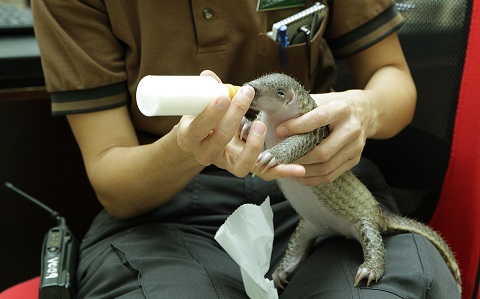
Sandshrew was bottle-fed with milk replacer in the early months of his life. Weighing at 522g upon arrival, Sandshrew was rescued and brought to WRS at an estimated age of one-and-a-half months. At that tender age, his chances of survival in the wild would have been slim. WRS vets made the decision to hand-raise him until he grew strong and independent enough for release.
PHOTO CREDITS: WILDLIFE RESERVES SINGAPORE
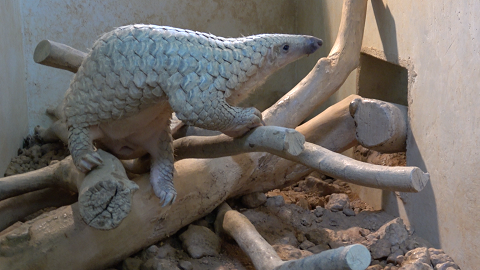
A year and nine months on, Sandshrew has grown to a healthy 6.4 kg. Vets have given him a clean bill of health after a medical checkup.
PHOTO CREDITS: WILDLIFE RESERVES SINGAPORE
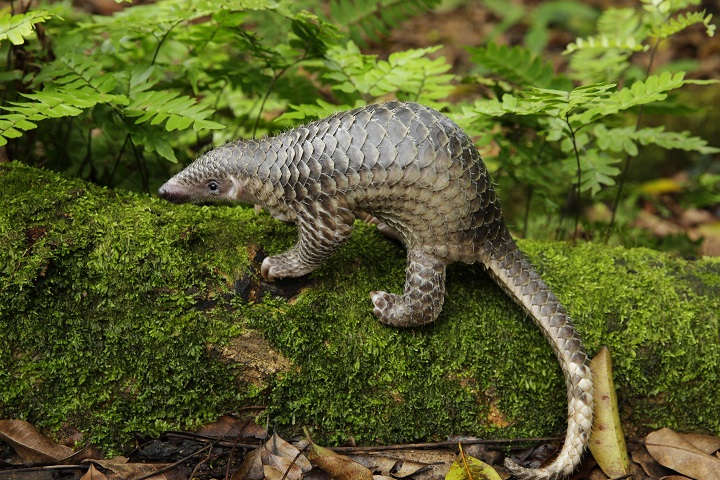
Sandshrew was also taken on daily walks in his first few months, to condition him to natural surroundings where he could practice essential skills like digging and climbing.
PHOTO CREDITS: WILDLIFE RESERVES SINGAPORE

Ade Kurniawan, Life Sciences Associate (right) and Sandshrew’s current caretaker measures Sandshrew while Dr Charlene Yeong, Manager, Conservation Research and Veterinary Services (middle), and Veterinary Nurse Ng Qing Yi (left) look on, during a health check. Sandshrew now measures about 102 cm from head to tail, almost double his initial length.
PHOTO CREDITS: WILDLIFE RESERVES SINGAPORE
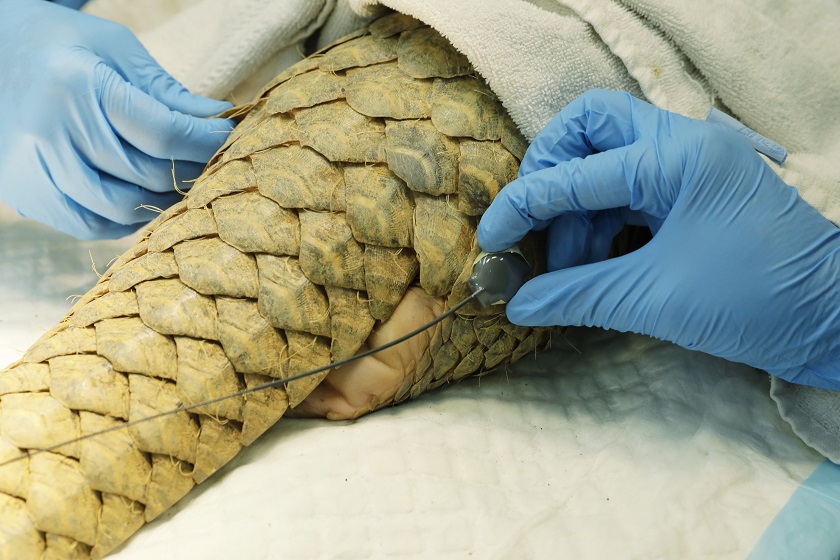
Sandshrew will be attached with a radio tracking device so that his movements can be monitored in the first few weeks after his release.
PHOTO CREDITS: WILDLIFE RESERVES SINGAPORE
Ade Kurniawan, Life Sciences Associate, Wildlife Reserves Singapore and Chung Yi Fei, Manager/ Conservation, NParks preparing Sandshrew’s soft release enclosure. Sandshrew will stay in his new home until he is accustomed to his the surroundings, after which the gate will be left open for him to leave voluntarily.
PHOTO CREDITS: WILDLIFE RESERVES SINGAPORE
